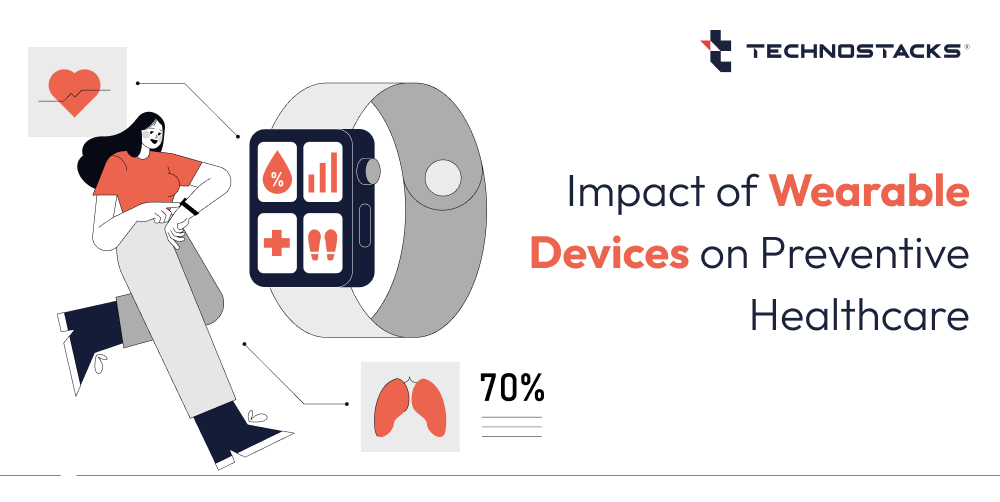The Impact of Wearable Devices on Preventive Healthcare
In the modern, fast-paced world, wearables are creating a new frontier in preventive health by tracking vital health metrics, helping early detection of diseases, and enabling healthy lifestyle changes.
It allows for intelligent tools, from activity trackers to biosensors, to play their key role in modern medicine. They represent the future of personalized healthcare, wherein the wearable healthcare market may reach $69.2 billion by 2028.
This blog tends to explore their impact on prevention, early diagnosis, and lifestyle transformation.
Understanding Wearable Devices
Wearable devices are small and portable technologies that can easily be worn on the body to collect real-time data on several health parameters.
Development related to wearables has transformed from simple pedometers into sophisticated equipment with advanced sensors and algorithms that permit the monitoring of vital health parameters.
Types of Wearables in Healthcare
1. Fitness Trackers: These are devices manufactured by companies like Fitbit and Garmin to monitor one’s amount of physical activity, heart rate, and calories burned to stay fit and healthy.
2. Smartwatches: The Apple Watch and Samsung Galaxy Watch are examples of devices with advanced features such as ECG monitoring and blood oxygen tracking.
3. Medical-Grade Wearables: Medical-grade wearables are intended for continuous glucose monitors and wearables for ECG monitors to help patients with chronic diseases by providing very accurate health data.
4. Biosensors: Biosensors are devices that can measure certain metrics, such as hydration level or blood pressure, just like medical devices for clinical purposes.
Technologies Powering Wearables
Wearables rely on several cutting-edge technologies, including:
- Internet of Things (IoT):
- Artificial intelligence (AI): Data analysis for personalized recommendations.
- Biosensors: Improve measurement accuracy of key health indicators.
Integration of AI and Machine Learning in Wearables
Wearable healthcare technology has gone one step further with AI and machine learning. These offer predictive analytics and personalized insights, leading to early disease detection and preventive health care. A few exciting stats are as follows by statista study with numerous case studies include:
- By 2029, the global market for AI in healthcare will reach $148 billion.
- The use of wearable devices in the future can save up to 16% of all costs associated with hospital treatments in five years.
- About 88% of providers are investing in the solution of remote patient monitoring.
The Importance of Wearable Health Monitoring Devices
Wearable health monitoring devices are of great significance in modern health care because of the continuous monitoring of vital signs and the provision of real-time alerts in case any medical emergency occurs.
They help with early detection, assist in chronic disease management, and provide personalized care plans.
These devices provide easy, information-driven insights into preventive healthcare, improve patient outcomes, and reduce the need for frequent in-person consultations, thereby making healthcare more efficient and cost-effective.
Evolution of Wearable Technology:
Wearable technology is being used for much more than just step trackers and blood pressure monitors, including all-around health monitoring, preventive care, and proactive personal healthcare.
Chronic Disease Management:
Continuous health metrics tracking by integrated sensors allows for remote observation and timely medical interventions.
Accurate Diagnoses:
Wearables reduce inaccuracies by recording continuously and thus provide objective data-based insights for medical decisions.
Preventive Healthcare:
Wearables analyze historical data, user behavior, and medical records to anticipate the appearance of issues and enable timely interventions.
The Role of Wearable Devices in Preventive Healthcare
Preventive health care is the art of avoidance before the actual stroke of ailments. Wearables put at the fingertips of users an endless possibility of health monitoring, helping to make informed decisions concerning well-being.
Key Contributions of Wearables
- Vital Monitoring:
- Chronic Disease Management: Devices, like CGMs, help in empowering patients through disease management in diabetes, while wearable ECG monitors will enable heart patients to identify abnormalities.
- Improved Patient-Doctor Interaction: Wearables provide minute details of health reports, thus enabling precise diagnoses and treatment plans accordingly.
Wearable devices are revolutionizing the notion of preventive healthcare through the use of real-time information and insight.
Benefits of Wearable Technology in Healthcare
Wearable technology has revolutionized health care by monitoring the health condition of a patient in real-time and thus allows for the possibility of early detection of any problem, aiding in chronic disease management.
It ensures continuous physiological sign monitoring, easy access to vast resources of health information for value-based insights, and personalization within healthcare treatment plans through remote monitoring.
In addition, it cuts down healthcare costs through minimal hospital visits and smoothening the delivery of telehealth services, making life easier for both the patients and the providers.
Real-Time Health Monitoring:
Wearables are those devices that continuously monitor biometrics and inform the user or professionals in case of a critical condition, such as a heart attack, and the need to call for immediate help.
Access to Healthcare Data:
Automatic data collection will provide much more extensive and efficient insights for healthcare professionals without necessarily having to research or conduct surveys manually.
Early Issue Detection:
Subtle changes in the vital signs are monitored, and early prediction and intervention of health concerns will avoid severe conditions and complicated treatments.
Chronic Disease Support:
Remote monitoring allows for timely treatment updates and individualized plans without requiring frequent in-person check-ups.
Personalized Healthcare Plans:
Continuous wearable data allows for personalized treatments, serves telehealth, and helps one respond to changes in their health immediately.
Cost Reduction:
Wearables improve outcomes through reduced hospital visits and in-person appointments, decreased treatment costs, and enhanced convenience.
Impact of Wearables on Early Detection
One of the most revolutionary sides of wearables is how they’re capable of detecting health problems well in advance of actual symptoms appearing. A good example can be said to be the ECG feature on the Apple Watch, which has been quite instrumental in catching atrial fibrillation among its users and probably saving lives in the process.
How Wearables Aid Early Detection
- Identifying Irregularities: Devices can detect irregular heartbeats, blood oxygen fluctuations, and other vital signs.
- Chronic Condition Monitoring: Wearables will help in monitoring chronic conditions such as hypertension and diabetes through continuous monitoring of required metrics.
- Mental Health Insights: Monitor stress and anxiety levels to proactively address your mental health concerns.
Statistics and Case Studies
- A study in 2023 in The Lancet estimated that wearable devices detect heart irregularities with an accuracy of up to 97%, leading to timely medical intervention.
- The global wearable medical devices market was valued at USD 27.29 billion in 2022 and is expected to witness a growth of around 26.5% CAGR in the period from 2023 to 2030, indicating growing adoption and an increase in trust in wearables.
How Wearables Influence Lifestyle Changes
In addition to detecting basic disease detection, wearables keep individuals on the path toward behaviors promoting better health. There was real-time feedback upon receiving achievable fitness goals in real-time and tracking further realization for long-term change within everyday living.
Promoting Healthy Habits
- Goal-Setting Features: Wearables allow the user to set daily activities goals, such as the extent of steps taken or the calories burnt.
- Gamification: Several devices incorporate challenges and leaderboards that make fitness much more enjoyable.
- Sleep Tracking: Fitness trackers from Fitbit monitor sleep for better rest.
Behavioral Insights
Wearables can give people insights they could not obtain themselves by taking their data and transforming it into something useful for motivating them further.
Statistics Supporting Lifestyle Changes
- A report by Statista in 2024 showed that 70% of wearable users reported improved levels of physical activity.
- Wearables proved to be health-promoting, as within a year of using wearables, 50% of users achieved better sleep patterns.
Related Article: How Wearable Technology Can Be Helpful For Healthcare
Barriers to Adoption and Challenges
While wearable devices have immense benefits, there are also challenges on their wide diffusion:
1. High Costs: Advanced devices with medical-grade features remain expensive, hence inaccessible to many.
2. Privacy Concerns: Collection and storage of critical health data pose serious ethical concerns on the aspect of security.
3. Inaccuracy: Some of these wearables are not accurate in results, hence less reliable.
These are challenges that will have to be overcome if wearable technology is to continue growing and remain effective within the healthcare realm.
Future Trends in Wearable Technology
The future of wearables is promising; with innovations, they will also become more integral in the care of health:
- Advanced Sensors: Newer devices will track hydration levels, stress indicators, and other advanced metrics.
- AI-Driven Analytics: AI-driven analytics will unlock more accurate predictive insights to enable correct preventive care.
- Telemedicine Integration: AI-driven analytics will unlock more accurate predictive insights to enable correct preventive care.
- Aging Population Focus: Wearables can be developed targeting the population of senior citizens for health problems related to aging.
Conclusion
Wearable devices have become the mainstay in the field of preventive healthcare and have acted as a bridge between users and their health. They stand for early detection of diseases, helping people stay healthy and live better by developing better habits. With further development in wearable technology, the potential will indeed be great to revolutionize healthcare through earlier interventions that are also made more available and with ease. Though challenging areas do remain in this field of wearables that need due consideration, such as costs and privacy, its future is no doubt bright. Wearable technology adoption is not about being fit, but about adopting a very healthy and informed lifestyle.
FAQs
1. What is the role of wearable technology in healthcare?
Wearables in healthcare are all about disruption in the sector, really enabling the patient with granular data leading to actionable insight. Wearables let the patient collect their health information and send it in digitally, eliminating the need for in-person appointments.
2. What are wearable sensors for injury prevention?
Wearable sensors provide real-time feedback about the activation of muscles and also strain, thereby helping athletes to optimize movements and avoid injury.
3. What are wearable devices for health?
In theory, wearables could track in real time the blood pressure and heart rate of the patient at home to make sure the patient is recovering well. What’s happening in practice is a health system asking a primary care provider who’s seeing more than 20 patients a day to review 24/7 streams of data of vital signs being created.
4. How wearable technology is used in health and safety?
Some common examples of wearable safety technology include:
Smart PPE: Traditional PPE like helmets, safety vests, gloves, and goggles can be enhanced with sensors and communication.
5. Do you think wearable devices may be the future of health prevention?
Preventive healthcare where wearables leverage all three past data, user behavior, and medical history to create an unrivaled edge. By continuous real-time data recording of the health status, mthe edical fraternity will be in a vantage position to observe an emerging problem much before it results in adverse conditions.









